SCRIPT LANGUAGE="JavaScript"> {location.href="http://perso.wanadoo.fr/volaillepoultry/";}
Alsace (Poule d') -
Aquitaine -
Ardennaise
Sans-queue des Ardennes -
Barbezieux -
Bourbonnaise -
Bourbourg -
Bresse-Gauloise -
Caumont -
Caussade -
Charollaise -
Combattant du Nord (Grand)
Combattant du Nord (Petit) -
Contres -
Cotentine -
Coucou des Flandres -
Coucou de France -
Coucou de Rennes -
Cou-nu du Forez -
Courtes-Pattes -
Crèvecoeur -
Estaires -
Faverolles claire et Faverolles foncée -
Gasconne -
Gâtinaise -
Gauloise dorée -
Géline de Touraine -
Gournay -
Hergnies -
Houdan -
Janzé -
La Flèche -
Landaise -
Le Mans -
Le Merlerault -
Meusienne -
Limousine (coq de pêche) -
Lyonnaise -
Mantes -
Marans -
Pictave
The following excerpts are quoted from the Books about the Farm Yard
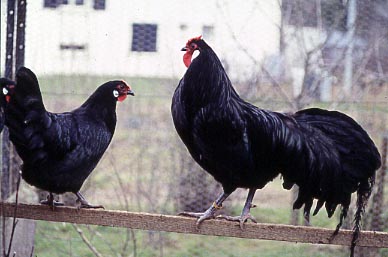 |
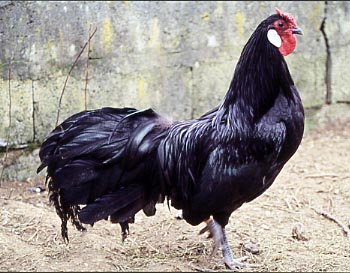 |
- Alsace (Alsatian hen)
: black, white, laced-blue,
gold-salmon.
- This breed was created in Alsace around 1890, but has existed for a long time in the area.
It is very similar to its German neighbour : the Rhenish hen (or Rheinländer). It is one of the few French
breeds not to have been crossbred
with Asiatic breeds. It is raised for its flesh and eggs.
- Cock : 2 to 3 kg : hen : 2 to 2.5 kg.
- It also exists as bantam.
- Address : Poule et Oie d'Alsace Club, Jean-Georges Eppinger, 28 rue de Soultz, 67250
Kurtzenhausen, France.
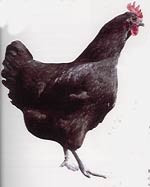 |
- Aquitaine :
black.
-
Rather recent race, selected from Australorp. Good sized fowl (cock : 4
to 4.5 kg ; hen : 3.5 to 4 kg), sturdy, light and jaunty appearance , plumage with no fluff.
Appears to be extinct.
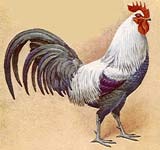 |
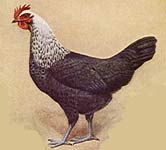 |
- Ardennaise and Sans-Queue des Ardennes :
gold-salmon,
gold-salmon blue, silver-salmon, black, black with gold or silver neck hackle with laced (or not)breast,
black-gold, black-silver.
- Origin : Ardennes. The breed is more Belgian than French. Moderately large fowl
(cock : from 1.75 to 2.5 kg ; hen : 1.5 to 1.75 kg) with the characteristics of
the country hen of old. Proud bearing, lively, slim, it has stayed rather
wild. Of longuish shape. The cock has a very developed panache.
It also exists in bantam.
- Address : Conservatoire de l’Ardennaise, Jean Pierre Mathias, rue Vaux, 52250 Baissey, France.
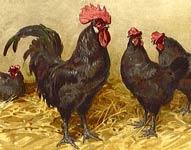 |
- Barbezieux
: black.
- Native in the Barbezieux area of the Charente region, the Barbezieux is a strong bird
(cock : 4.5 kg or more, hen : 3.5 kg or more), proud, powerful,
conceited attitudes but harmonious shape.One should select the
biggest animals with white ear-lobes. Excellent meat.
- Address : Association pour la sauvegarde de la poule de Barbezieux, J.C. Lamoine, Climat
de France, RN10, route de Poitiers, Angoulème nord, 16430 Champniers, France.
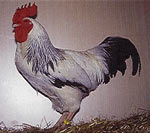 |
- Bourbonnaise
: light.
- Native of the Allier (Bourbonnais). Light heavyweight breed (Cock : 3.5 kg ; hen : 2.5 kg),
rather high on feet, elegant in spite of its size, oblique back and
prominent thighs ; very rustic fowl with excellent meat ; a good
brood hen which does a good job of rearing.
- Address : Bourbonnais Club, Christian Roy, 9 rue de Châtet, 03500 St Pourçain sur Sioule, France.
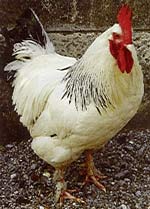 |
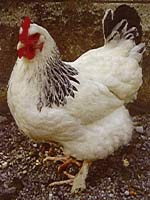 |
- Bourbourg
: light.
- It originates from the Bourbourg area of the North of France. Typical farm fowl, it is bred for
two reasons : eggs and meat. It is elegant and light and has a rather elegant appearance despite its weight
(Cock : 3 to 4 kg ; hen : 2.5 to 3 kg) , rather low position, with feathered feet.
- Address : Association des éleveurs de races Bourbourg, Edmond Chrastek, 70 avenue de la
libération, 62940 Haillicourt, France.
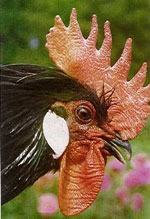 |
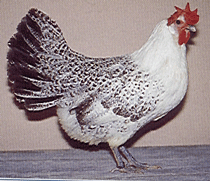 |
- Bresse - Gauloise
: black, white, blue, grey.
- This fowl traces its origins to the Bresse region. It should be made clear that this
designation (Bresse) only applies to a particular geographical zone,
the area of Bresse, which is defined and protected by legal provisions. Outside this zone, this hen
is referred to as Gauloise. Reputed for its flesh, it is known not only as "the queen of fowls" but
also as "the fowl of kings" because it used to be offered to kings and to newly-elected presidents
of the French Republic. It is also a good egg-layer.
- Cock : 2.5 to 3 kg ; hen : 2 to 2.5 kg.
- Address : Bresse-Gauloise Club, Thomassin Denis, Les Mirabelliers, rue Saint Germain, 54115
Battigny, France.
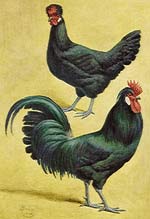 |
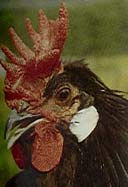 |
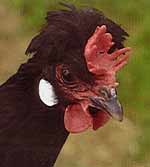 |
- Caumont
: black.
- Origin : Caumont l'Eventé (Calvados) in Lower Normandy. Rather stout fowl (Cock minimum 3
kg ; hen minimum 2.5 kg), proud and slim ; cylindrical body, raised tail. Comb
in tumbler or crown followed by a small crest.
- Addresses :
- Club pour la Sauvegarde des Races Avicoles Normandes, Bruno Lomenède, Le Buquet, 76750 Bosc Roger
sur Buchy. E-mail : brunolo@aol.com
- Conservatoire des races Normandes et du Maine, Pierre Le Maître , Le Mont Mirel, 14400 St Loup Hors, France.
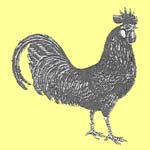 |
- Caussade
: black.
- Bears the name of the city of Caussade in Tarn-et-Garonne. A fowl of small
size (Cock from 1.5 to 2 kg ; hen 1.5 kg), it is rustic, alert and loves freedom. It is
of lively and elegant step, it is fine-boned, fine meat.
 |
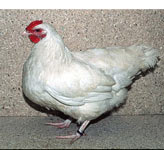 |
- Charollaise
: white.
- Origin : The Charolles area in Saône et Loire. A medium-sized fowl
(Cock 3.5 kg ; hen 2.5 kg), with strong breast, with horizontal and long back line,
prominent thighs with no fluff, medium tail, rose comb.
- Addresses :
- Jean-François Baudron, Bierre, 71120 Vendenesse les Charolles, France.
- Alloin Marie, Les Justices, 71170 Chassigny sous Dun, France.
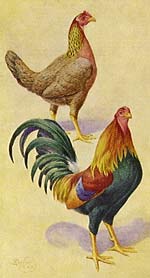 |
- Combattant du Nord (Northern Fighter)
: many colours.
- This breed originates from the departments of the North and Pas-de-Calais
where cockfights are still authorized. These fights are very popular and
involve betting which can sometimes attain very high stakes. The Combs and wattles of cocks are cut for the
fighting. Since these cocks are aggressive,they have to be bred separately.
- Cock : 4 to 5 kg ; hen : 2.5 to 4 kg.
- It also exists in Bantam and small varieties.
- Address : Club Français du Combattant du Nord, Jean-Louis Hoyez, 5 rue du Bois, 62620 Maisnil
les Ruitz, France.
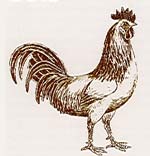 |
- Contres
: light.
- Bears the name of Contres, a market town of Loir et Cher.
Typical farm fowl of graceful proportions, drawn up
without being too high on its legs, lively and proud walk,
it has all the qualities of a farm hen raised for meat and eggs. Was recently reconstituted .
Cock : about 3 kg ; hen
2.25 kg
- Address : Jacques Berger , 33 rue Porte Balai, 45170 Villereau, France.
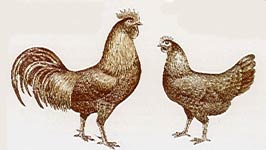 |
Cotentine : black.
- Origin : Peninsula of Cotentin and Normandy. It is bred both for meat and
laying. Farm type of medium size (Cock from 3 to 3.5 kg ; hen from 2 to
2.5 kg), elegant and proud.
- Addresses :
- Conservatoire des races avicoles de Normandie et du Maine ; Pierre Le Maître , Le Mont Mirel, 14400
Saint Loup Hors, France
- Club pour la Sauvegarde des races avicoles normandes, Bruno Lomenède, Le Buquet, 76750 Bosc Roger
sur Buchy, France. E-mail : brunolo@aol.com
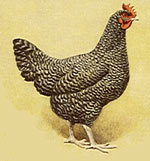 |
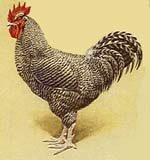 |
- Coucou des Flandres (Flanders Cuckoo):
cuckoo.
- Origin : region North - Picardy and Belgian Flanders. Second half of the
19th century. Stocky poultry, of medium size (Cock from 2.5 to 3 kg ; hen : 2
to 2.5 kg), well-built and not too high on legs, with simple comb, red wattles
and smooth tarsi. Hardy fowl well-adapted to the climate of Flanders.
Starts laying at an early age. The hen is an excellent mother and the chicks have a rather
fast growth and can be sexed at 3 weeks : young cockerels are
clearer than young hens who are almost black. Good producer of fine white
meat.
- Address : Club des Coucous de Flandres et de Picardie, Claude Dacheville, 239
chemin du Bois, 62350 Mont-Bernenchon, France.
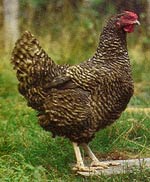 |
- Coucou de France (French Cuckoo) :
cuckoo.
- Origin : France, in two particular "departments" (areas) : the Sarthe and the Orne.
Light poultry (Cock : 2 kg ; hen : 1.5 kg), but sturdy with fine skeleton. Yet, it has well-developed
muscles. It has fine and very white meat ; rose comb.
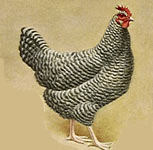 |
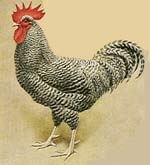 |
- Coucou de Rennes
: cuckoo.
- Selected by doctor Ramé in the Rennes region at the beginning of the 20th century. The standard set
out by doctor Ramé specifies that cocks and hens are both of the same shade (dark cuckoo) , though
genetically the cock is often clearer. Having almost disappeared a few years ago,
this breed is developing once again .
- Cock : 3.5 kg ; hen : 3 kg.
- Addresses :
- ANEVRB, Jean-Paul Cillard , 4 rue Pasteur, 35230 Bourg Barré, France.
- ASCR, Jean-Claude Herfray, La Gravelais, 35760 Saint Grégoire, France.
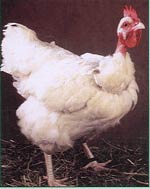 |
- Cou-nu du Forez (Forez Naked Neck)
: white.
- The region of Forez (Loire) is the birthplace of this fowl. The standard is
fairly recent. The Cou-Nu hens are reputed for being hardy. Its neck is
completely bare with the exception of a tuft of feathers in the middle,
set apart from the rest.
- Cock : 3 to 3.5 kg ; hen : 2.3 to 2.8 kg.
- Addresses :
- Jean-Pierre Refalo , La Thiau, route de Gien, 45250 Briare, France.
- Michel Pincemaille , 5 rue du Harde, 57640 Vigy, France.
- Stanislas Gornik , 6 rue des Lilas, 68210 Hecken, France.
- Gérard Patural , chemin des Sagris, 69440 Taluyers, France.
- Emmanuel Vichos , 18 rue Pablo Picasso, 42500 Chambon Fenguelle, France.
- Jean-Jacques Schurch , 20 rue de Ruelisheim, 68260 Kingersheim, France.
- Louis Chaussinand , Bessac, 43200 Yssingeaux, France.
- Thierry Tholy , La Malachère, 70190 Rioz, France.
- Daniel Desbois , Laverne, 42210 Saint Cyr les Vignes, France.
- Jo Triouleyre , Dignac, 43130 Roche en Régnier, France.
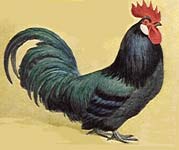 |
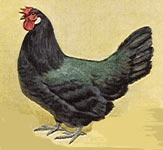 |
- Courtes-Pattes :
white, black, cuckoo...
- Origin : Old farm hen in the regions of Western France (and northwestern
Germany). Fowl with good long horizontal body ;
very short legs ; thick, long plumage . Of trusty temperament. Cock : 1.75 to 2.25 kg ; hen : 1.5 to 2 kg.
- Address : Conservatoire des races avicoles normandes et du Maine, Le Maître Pierre,
Le Mont Mirel, 14400 Saint Loup Hors, France.
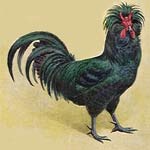 |
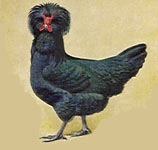 |
- Crèvecoeur
: black, white, cuckoo, blue.
- It is one of the oldest French breeds, named after the Norman village where it originates. At the
beginning of the 20th century it was probably the highest French breed being highly reputed for its meat.
After nearly disappearing, it is once again being reared by breeders. At present, however, it is often
considered as a decorative breed, which is a bad choice since the Crèvecoeur must recover those production
qualities it had in the past.
- Cock : minimum 3 kg ; hen : minimum 2,5 kg.
- Addresses :
- Club pour la sauvegarde des Races Avicoles Normandes, Lomenède Bruno, Le Buquet,
76750 Bosc Roger sur Buchy, France. E-mail : brunolo@aol.com
- Conservatoire des Races Normandes et du Maine, Le Maître Pierre, Le Mont Mirel, 14400 Saint Loup Hors, France.
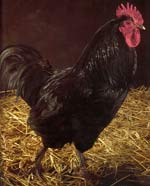 |
- Estaires
: black, black with gold-coloured neck hackle,
black with silvery neck hackle.
- Origin : near the village of Estaires in the North - Pas de Calais region.
Strong fowl (Cock from 3.5 to 5 kg ; hen from 2.5 to 3.5 kg), rather low on
legs. Slightly feathered feet.
- Address
: Palgalli Estaires Club, Bernard Dedours, 7 rue du Bacquet, 62620 Maisnil les
Ruitz, France.
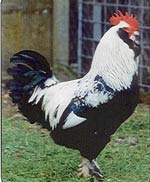 |
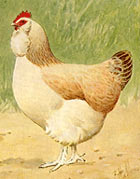 |
- (Clear) Faverolles
: salmon, cuckoo.
- It comes from the village of Faverolles (Eure-et-Loir). The product of
crossbreeding of farm hens with Brahma, Houdan, Dorking, Cochin and Langshan.
At the beginning of the 20th century, it had no standard. The breeders'
main concern was to produce a first class table fowl for the markets of the
nearby capital.
- Cock : 3.5 to 4 kg ; hen : 2.8 to 3.5 kg.
Powerful body, wide, deep, not too long ; owlish head, well-developed beard lightly feathered
tarsi, five toes ; the whole gives an impression of stately power, with no trace
of heaviness.
It is red and selected for its fine meat, early laying, as well as for the beauty of its
distinctive plumage.
- Address : HFCF, Michel Dono , 8 rue en Seille, 57590 Ajoncourt, France.
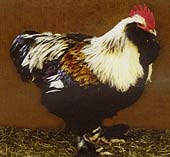 |
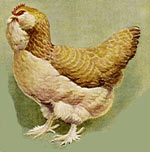 |
- German Faverolles (Dark Faverolles) : dark salmon, white, black, ermine.
- With its origins in Faverolles (Eure-et-Loir, France), the Dark Faverolles is a product of
selection in Germany for darker colour as well as for a more oblong body. A voluminous bird with a wide
and deep body, owlish head. It has a well-
developed beard, lightly feathered feet, five well-separated toes, very familiar in
character.
- It also exist in bantam
- Cock : 3.5 to 4 kg ; hen : 2.8 to 3.5 kg.
- Address : Houdan-Faverolles Club de France, Michel Dono , 8 rue en Seille, 57590 Ajoncourt, France.
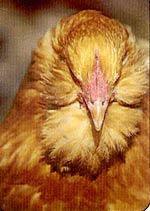 |
- Favoris
(not still approved) : buff
- Result of a crossbreeding of Faverolles and Orpington.
- Addresses :
- Houdan-Faverolles Club de France, Michel Dono , 8 rue en Seille, 57590 Ajoncourt, France.
- F et J. Fisher , 15 A rue de Bollenberg, 68500 Orschwihr, France.
- Jean-Pierre Refalo , La Thiau, route de Gien, 45250 Briarz, France.
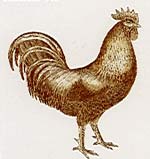 |
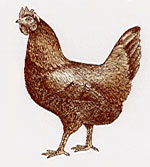 |
- Gasconne
: black.
- Origin : Valley of the Garonne in Southwestern France.
- Cock : 2.5 to 3 kg ; hen : 1.8 to 2.3 kg. It also exists in bantam. It is bred both for laying and
meat. It is medium-sized with fairly rounded outlines. It is slim, proud and elegant. It is hardy and
develops early ; fine-boned, looks like the Black Bresse Gauloise but the earlobes are red
and it is of larger size.
The preservation and the improvement of the original type should be sought as
well as that of its productivity.
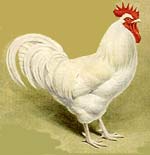 |
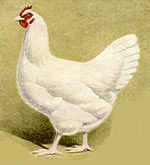 |
- Gâtinaise
: white.
- Native of the Gâtinais region, between Montargis and Sens, Seine-et-Marne and
Loiret.
- Cock : 3.5 to 4 kg ; hen : 2.5 to 3 kg. It also exists in bantam. White-plumed
fowl has existed from far-off days in these regions, a standard has therefore
been established to define these white fowl. The Gâtinaise is a dual-purpose fowl :
eggs and meat.
- Address : Gâtinais Club, René Evain, 5 rue de Ferrières, 77150 Lesigny, France.
 |
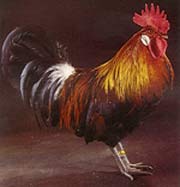 |
- Gauloise dorée
: gold-salmon.
- The oldest French farm-typed breed. This breed is featured as the "coq
gaulois" (the French cockerel), which is the emblem of the French fighting spirit. It is
also the French breed coming nearest the wild "coq Doré" (golden
cockerel)which is considered to be the ancestor of all our domestic breeds. It
nearly disappeared after World War 2 but it is now making a comeback thanks
to the efforts of breeders.
Cock : 2.5 kg ; hen : 2 kg.
- Addresses :
- Bresse-Gauloise Club, Denis Thomassin , Les Mirabelliers, rue Saint Germain, 54115 Battigny, France.
- Gauloise Dorée Club de France, Nicolas Vermeulen, 14190 Saint Germain le Vasson, France.
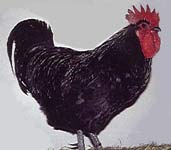 |
- Géline de Touraine
: black.
- Native of Touraine, it is a hardy and lively farm fowl with compact, white, very delicate and
fine meat. The ample and long fine-boned type should be sought.
- Cock : 3 to 3.5 kg ; hen : 2.5 to 3 kg.
- Addresses :
- Groupe informel des amis de la Géline de Touraine, Choisel Jean-Louis, 36 rue Bel-Air, 37320 St Branchs, France.
- Union des amateurs de la Géline de Touraine, Pierre Bas, 24 rue de la Gare, 37310 Reignac, France.
- http://www.indre-et-loire.chambagri.fr
- http://www.multimania.com/beuillotte1/
- http://beuillotte.ifrance.com/
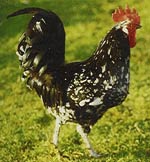 |
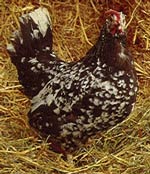 |
- Gournay
: black mottled.
- Origin : Gournay en Bray, Normandy.
It is an elegant farm fowl with rounded outline and tight plumage.
- Cock : minimum 2.5 kg ; hen : minimum 2 kg.
- Addresses :
- Club pour la Sauvegarde des Races Avicoles Normandes, Bruno Lomenède, Le Buquet, 76750 Bosc Roger sur
Buchy. E-mail : brunolo@aol.com
- Conservatoire des races normandes et du Maine, Le Maître Pierre, Le Mont Mirel, 14400 St Loup Hors.
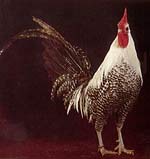 |
- Hergnies
: « grey ».
- Origin : department of North.
- A dual-purpose fowl on account of laying and meat. Early development, lively and hardy.
Unusual plumage colors and patterns.
- Cock : 2.5 to 3 kg ; hen : 2 to 2.5 kg.
- Addresses :
- Conservatoire des races du Nord et de Picardie, Bernard Dupas , 6 allée des Roses, 59400 Awoingt, France.
- Braekel-Hergnies Club de France, Pascal Kamp, 85 rue de la Victoire, 62110 Hénin-Beaumont, France.
- http://perso.wanadoo.fr/la-basse-cour-du-nord
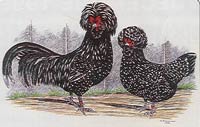 |
- Houdan
: black mottled with white, white, black, pearl grey.
- This very old breed (17th Century), a native of Houdan and its region was bred from Poland
and native hens from the Houdan (Yvelines)area. At the beginning of the 20th century, it
was reputed for its meat and provided very particular fatted chicken of Houdan. It
is a good sized fowl with a wide, long, cylindrical but elegant body, noticeable for its
particular crest, comb and fifth toe . One should select birds with a large frame and avoid
hypertrophied crests.
It is making a noticeable comeback in its region
as a table fowl of quality.
- Cock : 3 kg ; hen : 2.5 kg.
- It is also exists in bantam.
- Address : HFCF, Michel Dono, 8 rue en Seille, 57590 Ajoncourt, France.
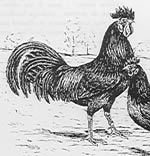 |
- Janzé
: black.
- Bears the name of the city of Janzé in Ille-et-Villaine.
Cock : 2.5 kg ; hen : 2 kg. An elegant fowl with well-proportioned shapes,
haughty and lively. Of medium size, it seems to be lighter on account of its extremely tight
plumage. Very fine, stiff and light-boned structure.
- Address : ANEVRB, Jean-Paul Cillard , 4 rue Pasteur, 35230 Bourg Barré, France.
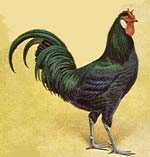 |
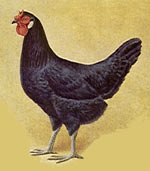 |
- La Flèche
: black, white, cuckoo, laced blue, pearl grey.
- A very old French breed known to have existed since the 15th century. Its
origins can be traced to the town of La Flèche in the Sarthe. Its reputation
comes from the excellence of its meat : the capons and fatted chickens of La
Flèche were famous in the past. This breed has not yet recovered its former luster.
A big fowl, proud, looks distinguished. It is lively and a good egg layer with specific
head ornaments. It is necessary to select the more vigorous birds.
- Cock : minimum 3.5 kg ; hen : minimum 3 kg.
- It also exists in bantam.
- Address : La Flèche Club Français, Christian Keller , 1 rue des vergers, 67120 Molsheim, France.
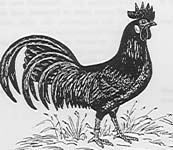 |
- Landaise
: black, grey.
- Origin : Region of Landes and some areas of Gascony. Elegant and long in building, rather fine-
boned. A good forager, it thrives well in the open.
Good egg layer.
- Cock : 2,5 to 3 kg ; hen : 1,8 to 2,3 kg.
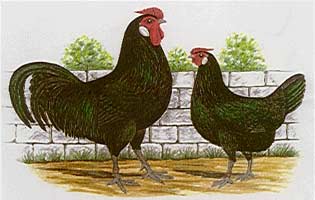 |
- Le Mans
: black.
- Origin: department of the Sarthe, in the neighbourhood of the city of Le Mans.
- Good sized fowl (Cock : 3 to 3.5 kg ; hen : 2.5 to 3 kg), long, wide ;
less corpulent than the "La Flèche" but elegant.
- Addresses :
- La Flèche Club, Christian Keller , 1 rue des vergers, 67120 Molsheim, France.
- Conservatoire des races de Normandie et du Maine, Le Maître Pierre, Le Mont Mirel, 14400 St Loup-Hors, France.
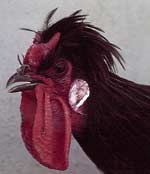 |
- Le Merlerault
: black.
- Farm fowl of Normandy,of good size and stocky. One should look for moderate crested
birds without any beard and provided with a horned comb with no ramification.
Good laying hen, seldom broods.
- Cock : minimum 3 kg ; hen : minimum 2.5 kg.
- It also exists in bantam (created by J.C. Périquet).
- Addresses :
- Club pour la Sauvegarde des Races Avicoles Normandes, Bruno Lomenède, Le Buquet,
76750 Bosc Roger sur Buchy. E-mail : brunolo@aol.com
- Conservatoire des races normandes et du Maine, Pierre Le Maître , Le Mont Mirel, 14400 St Loup Hors, France.
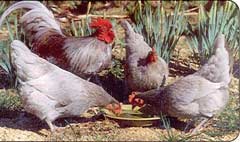 |
- Limousine : Fishing Cock of the Limousin
: blue, black.
- It traces its origins to an old farming breed of the granitic regions of the
Limousin, particularly in High Corrèze (at moderate altitude and under brisk
climatic conditions). Its standard has only recently been set and recorded.
Medium sized fowl, fine-boned, very hardy. A good layer and
brooder, but especially sought after because of the plumage of the cock
the blue variety of which lends itself to the manufacture of fishing lures.
The feathers to harvest are neck hackles, shovels (back and wings) and
saddle hackles : they should be solid but flexible and as little downy as possible with
free and stiff beards. Ensure that the original characteristics and particular qualities of
the type are preserved.
- Cock : 2.5 to 3 kg ; hen : 2 kg. It also exists also in bantam.
- Address : Club de la Limousine, Gérard Roumilhac, Le Bourg, 87340 Saint Laurent les Eglises, France.
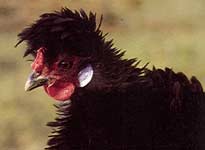 |
- Lyonnaise
: black.
- Origin : region of Lyons ; creator : Etienne Tamburini. Poultry with plumage curled on the back,
on the wings and on the breast with a small crest on the head.
Very original race providing excellent and fine meat. It belongs to the middle races (Cock 2.5
kg ; hen : 1.5 kg), while being approximately of the same size as Hamburg and Bresse ; fine skeleton.
- It also exists in bantam.
- Address : Joubert Georges, 12 rue Ponsard, 38100 Grenoble, France.
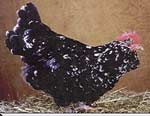 |
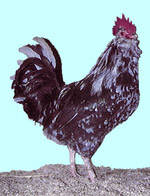 |
- Mantes
: black mottled.
- An old French race resulting from crossbreeding between Houdan and Brahma. That race disappeared for
fifty
years, but was recreated on the spot in Mantes-la-Jolie by Alex Wiltzer,
- Cock : 2.5 to 3.5 kg ; hen : 2 to 2.5 kg.
- Poultry of good-middled size. Wide, long, cylindrical but elegant body.
- Address : Houdan-Faverolles Club de France, Michel Dono , 8 rue en Seille, 57590 Ajoncourt, France.
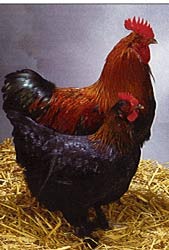 |
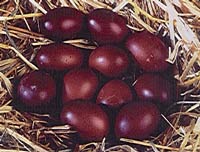 |
- Marans
: copper black, silver cuckoo, golden cuckoo, wheaten, white,
white with black bars, tawny with black tail.
- Tracing its origins from the town of Marans, near the Atlantic ocean, this breed
is the result of cross breeding with fowls brought back by sailors who had stopped over in
that town. The Marans is probably the pure French breed most frequently found among
private poultry keepers. This success is due to the quality of its eggs , in
particular to its noticeable extra-red colour.
Cock : 3.5 to 4 kg ; hen : 2.6 to 3.2 kg. ; cockerel 3 to 3.5 kg, pullet 2.2 to 2.6 kg.
It also exists in Bantam.
A good-sized fowl, of medium height. It gives an impression of robust hardiness and of lightness of
movement. Its plumage is close to body. Selected for production of large and extra red eggs.
- Address : Marans Club de France, Serge Déprez , rue de l'Eglise, 02500 Ohis, France.
- Meusienne
: dark salmon.
Page exclusively devoted to this breed : please click here
- Address :
Club de la volaille Meusienne, Jean-Claude Périquet, 3 hameau de Pierreville, 55400 Gincrey, France.
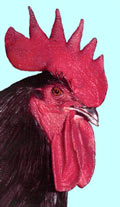 |
- Noire du Berry
: black.
- Origin : Origin : region of Berry, old province formed by the departments of the
Indre and Cher. This fowl is used for a dual-purpose : its early laying and its fine tasty meat.
- Cock : 3 kg ; hen : 2.3 kg.
- Addresses :
- Etienne Grosset , Tilloux, 36500 Saint Lactencin, France.
- Alain Pradine , La Piffourne, 89240 Chevannes, France.
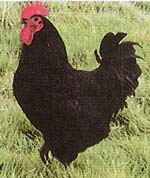 |
- Noire de Challans
: black.
- Origin : region of Challans, Marchecoul, Beauvoir sur Mer, the Swamp of Bouin
in Vendée. A medium sized fowl (Cock : 3 to 3.5 kg ; hen : 2 to 2.5 kg),
but powerful, sturdy and jaunty without any heaviness. It has a little close to the ground ;
its plumage is without fluff.
- Addresses :
- Robert Crépeau , Le Bosquet de la Pironnière, 85280 La Ferrière, France.
- Vincent Duranceau , 8 rue de la Gare, 85320 La Bretonnière, France.
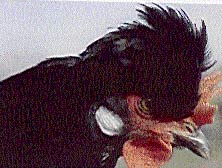 |
- Pavilly
: black.
- Origin : The Yvetot area of Normandy. The village of Pavilly was the site of a sizeable
poultry market which supplied the town of Rouen.
The Pavilly is a utility fowl whgich is lively and hardy. Main characteristics : small crest, simple
white ear-lobes.
- Cock : minimum 3 kg ; hen : minimum 2.5 kg.
- It also exists in bantam (created by J.C. Périquet and approved in 2001).
- Addresses :
- Club pour la Sauvegarde des Races Avicoles Normandes, Bruno Lomenède, Le Buquet, 76750 Bosc Roger
sur Buchy, France. E-mail : brunolo@aol.com
- Conservatoire des races normandes et du Maine, Pierre Le Maître , Le Mont Mirel, 14400 St Loup Hors, France.
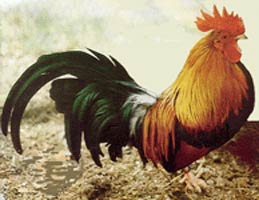 |
- Pictave
: salmon-gold
- As suggested by its name, the Pictave is from Poitou. At first, it was
selected for the purpose of brooding and rearing young pheasants. Relatively close
to the ground, with a long and plentiful neck hackle, well developed tail. Only
original French bantam, it doesn't have any equivalent in large size.
- Cock : 800 g ; hen : 600 g.
- Address : Bantam Club Français, Michel Lacour, 102 route de Longpont, 91700 Ste
Geneviève des Bois, France.
All these excerpts are quoted from the
Books about the Farm Yard


































































